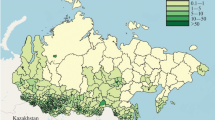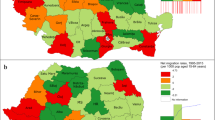Abstract—
The article examines change in the effects of spatial connectivity of Russian regions’ economic activity for 1997–2016. Quantitative estimates are obtained using spatial econometrics methods. Two specifications of the model are used: the spatial lag model and spatial error model. Relations between regions are modeled through spatial external effects, which are described in two ways: using a nearest neighbor matrix and an inverse distance matrix. The following hypotheses are tested: (1) a single macroeconomic policy and market integration stimulate growth in the spatial connectivity of economic activity; (2) Russia’s western territories have closer spatial ties compared to the eastern; (3) imposition of sanctions against Russia stimulated the formation of new and strengthened existing internal ties, as well as the country’s spatial connectivity. Estimates have shown that there are no distinct trends in the spatial connectivity of economic activity in Russia, nor were interregional interactions affected by international sanctions. Relations important for economic activity are supported mainly with neighboring regions. The cooperation that arises between regions is not deep spatially and fades rapidly with increasing distance. This is also confirmed by the fact that for European Russia, spatial relations are a more significant development factor than for eastern regions.






Similar content being viewed by others
REFERENCES
Abreu, M., de Groot, H.L.F., and Florax, R.J.G.M., Space and growth: a survey of empirical evidence and methods, Reg. Dev., 2005, vol. 21, pp. 13–44.
Goryunov, A.P. and Belousova, A.V., Integration and fragmentation processes in the economic space: the structure of settlement pattern systems, Prostr. Ekon., 2017, no. 4, pp. 81–99.
Granberg, A.G., Suslov, V.I., and Syspitsyn, S.A., Mnogoregional’nye sistemy: ekonomiko-matematicheskoe issledovanie (Multiregional Systems: Economic and Mathematical Study), Novosibirsk: Sib. Nauchn. Izd., 2007.
Granberg, A.G., Suslov, V.I., and Syspitsyn, S.A., Economic and mathematical studies of multiregional systems, Reg.: Ekon. Sotsiol., 2008, no. 2, pp. 120–150.
Kolomak, E.A., Spatial externalities as a resource for economic growth, Reg.: Ekon. Sotsiol., 2010, no. 4, pp. 73–87.
Krugman, P., Space: the final frontier, J. Econ. Perspect., 1998, vol. 12, no. 2, pp. 161–174.
Perroux, F., Economic space: theory and applications, Quart. J. Econ., 1950, vol. 64, no. 1, pp. 89–104.
Semerikova, E.V. and Demidova, O.A., Use of spatial econometric models to forecast regional unemployment, Prikl. Ekonometr., 2016, no. 3, pp. 29–51.
Ekonomiko-geograficheskie i institutsional’nye aspekty ekonomicheskogo rosta v regionakh (Economic-Geographic and Institutional Aspects of Economic Growth in Regions), Moscow: Inst. Ekon. Perekhodnogo Perioda, 2007.
Anselin, L., Spatial econometrics, in Palgrave Handbook of Econometrics, Vol. 1: Econometric Theory, Mills, T.C. and Patterson, K., Eds., Basingstoke: Palgrave Macmillan, 2006, pp. 901–969.
Gluschenko, K., Price convergence and market integration in Russia, Reg. Sci. Urban Econ., 2011, vol. 41, no. 2, pp. 160–172.
Lopez-Bazo, E., Vaya, E., and Artis, M., Regional externalities and growth: evidence from European regions, J. Reg. Sci., 2004, vol. 44, no. 1, pp. 43–73.
Vaya, E., Lopez-Bazo, E., Moreno, R., and Surinach, J., Growth and externalities across economies: an empirical analysis using spatial econometrics, in Advances in Spatial Econometrics: Methodology, Tools and Applications, Anselin, L., Florax, R.J.G.M., and Rey, S., Eds., Berlin: Springer-Verlag, 2004, pp. 433–455.
Funding
The study was supported by the Russian Foundation for Basic Research (project no. 19-010-00094 “Spatial Development of Modern Russia: Trends, Factors, Mechanisms”).
Author information
Authors and Affiliations
Corresponding author
Ethics declarations
The author declares that she has no conflicts of interest.
Rights and permissions
About this article
Cite this article
Kolomak, E.A. Estimation of the Spatial Connectivity of the Economic Activity of Russian Regions. Reg. Res. Russ. 10, 301–307 (2020). https://doi.org/10.1134/S2079970520030089
Received:
Revised:
Accepted:
Published:
Issue Date:
DOI: https://doi.org/10.1134/S2079970520030089




